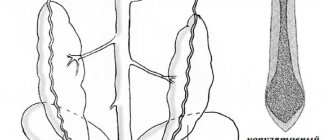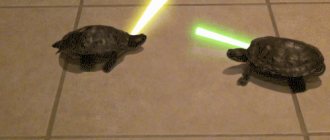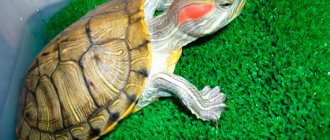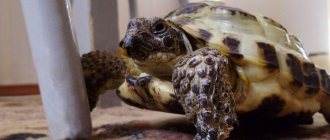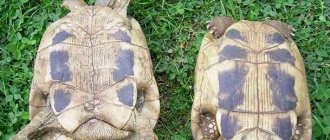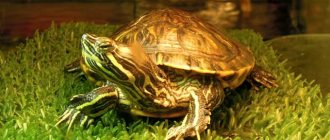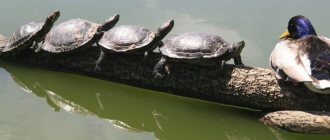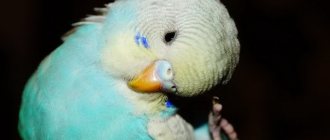Molting time for red-eared turtles
Do not be alarmed when the red-eared slider begins the molting process. This is a natural process that occurs in a young individual during a period of active growth. The reptile grows quite quickly and the shell simply cannot keep up with its growth. Therefore, all or part of the shell peels off. This process is absolutely safe for the turtle, but during this period it needs special care.
A turtle in the early stages of its development may experience complete peeling of the top layer of its shell. As the turtle matures, the amount of dead tissue decreases. This is no longer the entire upper layer of the reptile’s shell, but only part of it. After some time, the red-eared slider's molting stops.
Diseases
Many people will probably be surprised, but the most common disease of the red-eared slider is pneumonia. It will become clearer to many if we call the disease differently - pneumonia. Veterinarians do not recommend keeping these animals outside of the aquarium. Many owners often let their pets walk around the apartment, being in full confidence that this will be useful for their pet. In reality, everything may be different - the turtle may get caught in a draft and catch a cold. The same can be said about the location of the terrarium - place it in a place protected from drafts and wind.
Features of caring for your pet during the molting period
During the molting period of your pet, special attention should be paid to its nutrition. There is no need to radically revise your diet or change your diet. It is enough to add products containing calcium and vitamins to it. To replenish the loss of these substances, it is recommended to give the turtle small fish or crustaceans. You can also buy food for young turtles in specialized stores.
Also during the molting period, it is important to monitor the cleanliness of the turtle’s home and the aquarium. The thing is that dying shell particles float on the surface, thereby polluting the water. Dirty water is a favorable environment for the development of bacteria. Therefore, you should change the water as often as possible or install a filter in the aquarium.
Some owners try to speed up the molting process of their turtle by forcibly removing the top layer of the shell. This is strongly not recommended. You can help remove a layer of shell if the turtle cannot do this on its own for a long time. A shell that does not peel off is uncomfortable for the turtle and can cause injury and poor health.
To speed up the molting process, you can gently wipe the shell with a decoction of chamomile flowers. You can remove the turtle from the aquarium for a while and let it dry completely. Dry scales will peel off more easily and fall off as the turtle crawls or swims in the aquarium.
During the molting period, experts advise bathing turtles to remove remaining dirt from under the shell scales and prevent them from rotting. For swimming you will need a small container with low sides. Fill it with warm water and add baking soda at the rate of 1 teaspoon per liter of water. Carefully lower the turtle into the container so that its head remains on the surface. After 20 minutes of taking a bath, take it out, carefully blot off excess water with a towel and apply a few drops of olive oil to the shell.
Diseases in which the skin peels off
It is normal for a reptile's skin to peel and flake off during the molting period. As soon as the animal is raised, everything is over.
But sometimes peeling skin can be a sign of pathology.
The clinical picture of the following diseases resembles the molting process:
- Mycosis. Most often, a fungal infection develops in the spring, when the animal’s immunity is weakened, especially if it hibernated. With this disease, you can notice a white coating on the skin, which can be easily removed with a cotton swab. If the animal moves and touches various objects, then white stripes remain on them.
- Rickets. With this pathology, the shell becomes bent and may begin to peel off. The eyes may become swollen, causing them to close completely. Due to the curvature of the jaws, the turtle does not eat anything, which can cause death.
- Hypovitaminosis. If an animal’s diet is monotonous and it does not receive all the necessary vitamins, then it may develop vitamin deficiency. Hypovitaminosis A is manifested by peeling of the skin. There is desquamation of large scutes on the limbs and head, marginal blepharitis, in which the eyelids swell, and the cloaca prolapses. The reptile grows a “parrot-like” beak. Often, with hypovitaminosis A, a runny nose is observed, so the disease is confused with a bacterial infection. Also, the animal may not eat anything, which will cause the reptile to become exhausted. To prevent the development of vitamin A deficiency, the pet must constantly receive liver, fish entrails, carrots, and pumpkin.
How not to miss a disease in a turtle
When turtles molt, it means the reptile is developing normally. This is a sure sign that the turtle is growing and after some time, with normal development, will grow into a large adult.
However, owners of red-eared turtles need to be aware that there are several diseases whose symptoms resemble molting as the turtle grows. The reptile's shell begins to peel off due to fungal diseases or a lack of vitamins obtained from food. In this case, you should definitely take your pet to the veterinarian so that he can help adjust the diet or give recommendations for treatment.
Also, a soft shell, bruises and an unpleasant odor may indicate burns or injuries to the shell and the development of a bacterial infection as a result. Such cases should be treated immediately with antibiotics as prescribed by a veterinarian.
If it is not possible to show your pet to a veterinarian, then you need to examine it yourself. The inspection must be carried out very carefully so as not to damage the turtle’s shell. If the examination does not reveal any deviations from the norm, and the turtle eats normally and is active, then this is its normal molting period. There is only one thing to remember - a turtle sheds when it grows, molting as an adult is a sign of disease.
Causes of the disease
Detachment and rotting of the turtle shell and the formation of ulcers can occur due to the following reasons:
1. Fungal (mycotic) infection. Characterized by mild inflammation and stench. However, fungal infection is more dangerous than microbial infection. This is due to the absence of clinical manifestations of the disease.
Fungi are a possible cause of extensive damage to the shell.
Factors predisposing to the development of a fungal infection in the shell are injuries, malnutrition, an immunosuppressive state, hypothermia, lack of essential vitamins and microelements, etc.
2. Bacterial damage.
The cause of this pathology is gram-negative anaerobic bacteria. Weakened turtles are susceptible to this infection.
A layer of necrotic and purulent masses forms in the area of damage to the shell. This helps create conditions for further proliferation of microbes. Pus has a very foul odor.
Juvenile molt
In animals with outer skin, it is regularly replaced, which is called molting. In invertebrates, as well as turtles, the growing body no longer fits into the protective shell. The exoskeleton is shed, and a new one grows to replace it. In young reptiles, shell detachment is observed twice in a month. Initially, complete molting occurs. Gradually, the intervals between stratifications increase; instead of being continuous, they become partial.
With each molt, the percentage of shed cover decreases. As the reptile reaches sexual maturity, which occurs at 4–6 years, the horny frame ossifies and the shedding of the exoskeleton stops. Peeling of the shell in adults is considered a pathology and is the basis for contacting a herpetologist.
To make the exoskeleton rotation process painless, you should do the following:
- Change the water in a timely manner.
- Maintain the temperature of the aquarium 22–28 °C, the temperature of the shore - at least 21 °C.
- To free the turtle from shell scales, rub its back with chamomile infusion. Dry on a warm shore.
- Preventative twenty-minute bathing in a soda solution (a spoon per liter of liquid). After drying with a towel, apply vegetable oil to the shell.
- Complete feeding with specialized nutrition. If necessary, the turtle is fed with fish and crustaceans. A mineral stone is placed in the aquarium.
Pathological shedding
Pathological peeling of the exoskeleton is called shell ulcer. It occurs mainly in mature individuals with weakened immunity due to vitamin deficiency, non-compliance with living conditions - cold, dirty water. The integrity of the keratin layer is disrupted and a fungal or bacterial infection penetrates the soft tissue. Suppuration develops, characterized by stench, ulceration and rejection of the stratum corneum.
Treatment consists of surgical removal of necrotic tissue, treatment of wounds with disinfectants, as well as antimycotic or antimicrobial agents. It occurs in stages so that an extensive wound surface is not created. If necessary, the herpetologist performs prosthetics with polymer materials until the stratum corneum is completely restored. The turtle owner will have to be patient - healing may take months. Therapeutic procedures will not be effective without providing the pet with comfortable housing, as well as adequate feeding.
The essence and main features of turtle molting
Molting in turtles is a natural process that does not depend on the season, so reptiles molt both in summer and winter. The frequency of shedding is influenced by the environment, which is determined by the care and maintenance of the animal.
During molting, the turtle's shell may peel off. The detachment is explained by the active growth of the body, outstripping the growth of the shell, and has the following features:
- It is observed only in young individuals. In young reptiles, the entire film connecting the skin to the armor plates peels off. They shed their skin and change their shell about 2 times every month.
Natural molting in a young individual Loses frequency and intensity as it matures. As your pet ages, only individual plates and small areas of skin peel off. More intense peeling is a cause for concern. If the shell peels off on an adult turtle over 2 years old, sound the alarm. In this case, the cause is pathology, since the growth of the body is completed at this point.
In an adult, molting of the entire shell is a manifestation of pathology
IMPORTANT! When keeping an aquatic turtle, you should not overuse land walks, which slow down the molting process. Prolonged trips to land upset the balance between moisture and dryness of the shell.
The intensity of molting depends on the type of reptile:
- Molting in land turtles is weakly expressed. In these reptiles, only the skin peels off, so they do not shed their shell.
Molting in a land turtle Molting in red-eared turtles affects all areas of the body. Tatters form on the neck and limbs, and dead shell scales fall off on the back.
Shell detachment
IMPORTANT! If the skin peels off too much and becomes covered with a whitish film, then the problem can be solved with a few drops of blue added to the water of the aquaterrarium. You can purchase the drug at any pharmacy.
Video: what molting looks like in a red-eared turtle
Video: what molting looks like in a land turtle
Turtle: skin and appetite problems
Why doesn't the turtle eat and its skin peels?
Unfortunately, you did not indicate the type of turtle (land, aquatic) and its species (red-eared or Central Asian reptile). You also did not inform about the conditions of detention, and such information could help answer your question more accurately. Well, we will rely on the information that is available. The ideal option would be to take your pet to a herpetologist, but since it is not so easy to find a veterinarian who specializes in reptiles, we will try to sort out the problems in absentia.
Refusal to eat
A turtle's lack of appetite does not always indicate illness. It is more common for unhealthy mammals to refuse food. Still, if the reptile has not eaten for several days, you need to be wary. Even if there are no other reasons for concern, no other symptoms are observed, carefully monitor the behavior and well-being of your pet. If about 10 days have already passed and the animal still does not eat, you need to contact a specialist.
Peeling skin
Since your pet is not only refusing food, but its skin is peeling, it can be assumed that it does not have enough vitamin A. It is necessary for the animal’s normal growth and healthy skin. Hypovitaminosis A is common in turtles not receiving vitamin supplements. Improper living conditions also often lead to a deficiency of this essential vitamin. In addition to lack of appetite and peeling skin, the following symptoms may occur:
- The horny scutes (especially the marginal ones) peel off.
- The eyelids swell.
- Horny tissue grows.
- The beak becomes similar to the beak of a parrot.
- The organs of the cloaca fall out.
The condition is often accompanied by blepharoconjunctivitis and necrotizing stomatitis. If a reptile's body lacks this vitamin, it often manifests itself as a bacterial disease. Your pet may have a runny nose with clear discharge. When refusing food, exhaustion and lethargy are often noticeable.
How to cure a turtle
All life processes in a reptile's body proceed relatively slowly. If symptoms appear, this means that the disease is in full swing. It is important not to waste time, because with such a metabolism, the treatment will not work immediately.
If the turtle suffers from a severe lack of this organic substance, you need to give an injection of a vitamin complex. Use "Eleovit" or "Multivit", the drug "Multivet" is suitable. They contain vitamin A, which reptiles need. Do not use other vitamin complexes - they are not suitable for turtles. The injection is given intramuscularly in the back of the body. You need to give 1 injection and wait two weeks, after which you need to give a second injection.
The dosage of “Multivet” and “Eliovit” is 0.8 ml/kg, if your turtle is a land turtle; 0.6 ml/kg if she is aquatic. If it is impossible to find the indicated drugs, and there is only injectable Introvit, you need to inject 0.8 ml/kg only once, do not give a second injection. Use the latter drug only as a last resort.
Attention! You cannot put oil-based vitamins into a turtle’s mouth - the risk of overdose and death is too high. If your pet does not get better in a couple of weeks and you do not notice obvious improvements, she needs to be prescribed antibacterial medications. Antibiotics are used both locally and in the form of injections. I wish your turtle a speedy recovery!
Detailed instructions for the owner of a molting turtle
Pets raised outside the wild are dependent on their owners and have a harder time going through natural processes. It is important for reptile owners to follow recommendations to facilitate the molting process and avoid possible troubles.
- Fortify your diet
. The turtle needs calcium to grow, so feed it small crustaceans and small fish straight from the bones, which can be easily crushed by the turtle's strong jaws. Be sure to consult your veterinarian regarding vitamins to avoid overdose. - Moisturize your skin
. Lubricate the rags on the paws and neck with a non-greasy cream or lavender balm, sold at the pharmacy. Remember not to lubricate the shell or use the cream for more than 5 days in a row. On day 6, take a break and apply the cream with a break of 1 day. - Have a swim
. When the scales on the turtle's shell come off, dirt containing pathogenic microorganisms gets trapped under them. You can bathe your pet no more than 2 times per molt. For this:- Buy a small container with a low side to prevent the turtle from being completely submerged.
- Fill it with warm water and dissolve baking soda in it (1 teaspoon of soda per 1 liter of water).
- Place the reptile in the water, leaving its head on the surface to breathe.
- wait 20 minutes and take your pet outside.
- wait until the shell dries and blot off any remaining moisture with a soft cloth.
Keep the terrarium clean
. If the skin of a red-eared turtle peels off, then its particles contaminate the water and start the process of decay. Pathogenic microflora increases the risk of viral infection, so it is important to promptly remove pieces of peeling skin and take care of high-quality filtration.
IMPORTANT! Do not use oils or balms to lubricate the shell. They fill the pores, causing disruption of air exchange and the development of fungus. Oily products are only suitable for moisturizing the skin.
. Speed up the molting of your red-eared turtle by smearing its shell with chamomile infusion. The smeared scales quickly dry out in the open air and fall off on their own without additional help.
. Help is needed if the dead skin does not come off for a long time, and the pet injures itself in attempts to get rid of it. When removing, follow these steps:
- Use a soft-bristled toothbrush. Stiff bristles can injure and frighten your reptile.
Gently clean off the thin plates of the shell using light massage movements.
Perform all actions smoothly, avoiding excessive pressure. IMPORTANT! White stains on a turtle's shell caused by hard water can be removed with lemon juice. To avoid a recurrence of the situation, use water that has passed through filters.
Pathological causes similar to molting and therapeutic measures to eliminate them
After growing up, red-eared turtles and land turtles do not molt, so the reason always lies in pathology. If the reptile is still young, then pay attention to the accompanying symptoms. The disease usually causes:
- decreased activity;
- loss of appetite;
- itching;
- infectious lesions (runny nose, conjunctivitis);
- disruption of the gastrointestinal tract.
With such signs, the animal should be shown to a doctor, since ignoring the problem can result in death.
IMPORTANT! The shell may peel off due to injury or burn. In this case, the shields become soft, blood flows out of the cracks and an unpleasant rotten smell emanates. To avoid infection, your pet needs to be seen urgently by a doctor who will determine the nature of the antibacterial therapy.
Trauma to a turtle's shell
The cause of peeling may lie in poor maintenance. If cleaning is poor, the water in the pool becomes dirty and becomes covered with algae, which spread to the shells. Attacked by overgrown plants, the shell peels off and falls off. To help the turtle, apply Lugol's solution with glycerin or a 1% solution of copper sulfate to its shell.
IMPORTANT! Do not keep the aquaterrarium in direct sunlight. An abundance of light is the best food for algae.
Among the main diseases reminiscent of the molting process are:
Let's take a closer look at them.
Rickets
When rickets develops in a sick animal:
- the shell is bent and individual scutes are peeling off;
- the eyeballs swell, which leads to complete closure of the eyes;
- Appetite is impaired due to crooked jaws, which make it difficult to absorb food.
Manifestation of rickets in a turtle
Due to the symptoms that appear, the turtle may die due to exhaustion. At the first signs of illness, your pet should be taken to a veterinary clinic to make a diagnosis and receive recommendations for treatment.
IMPORTANT! Therapy for rickets is individual. Self-treatment may worsen the situation.
Deformation of the shell and failure of the hind limbs with rickets
Mycosis
Fungal diseases affect reptiles with weakened immune systems due to:
- recent hibernation;
- low temperature in the terrarium;
- poor quality diet;
- past infections;
- dirty water.
IMPORTANT! Fungi are the main enemies of aquatic reptiles. Land turtles are infected less frequently.
For mycosis in a turtle:
- the skin peels off and sheds;
- white spots appear on the shell, which can be easily cleaned off with a cotton swab;
- severe scabies occurs;
- Pimples and swellings form on the skin, developing into ulcers due to scratching.
Manifestation of mycosis in a turtle by the appearance of white spots
A sick animal needs to change its living conditions by increasing the frequency of cleaning the terrarium. To select medications, consult your veterinarian. The list of main drugs is presented:
To improve the condition, irradiation with a UV lamp and taking multivitamins are also recommended.
Avita- or hypovitaminosis
The essential vitamins needed for good reptile health include:
- calcium, responsible for bone tissue;
- vitamin D3, which regulates the functioning of the immune system and endocrine glands;
- vitamin A, which slows down the aging process and stimulates the growth of new cells.
Disorders in the musculoskeletal system due to lack of vitamins
With a poor diet and lack of vitamins in a turtle:
- the skin begins to peel off;
- armored shields peel off;
- rhinitis and blepharitis appear;
- loss of appetite;
- deformation of the paws is noted;
- the intestine falls out of the anus;
- the mucous membranes of the eyes turn red;
- bite changes;
- stool is disturbed;
- It is difficult to rise on the limbs due to increased fragility of the bones.
Pathological peeling of the skin more than twice a month
To restore health, consult a veterinarian and create an individual diet that takes into account the characteristics of your pet.
Useful video
Turtles are very cute pets that live quite a long time and bring joy to their owners every day. Of course, keeping a turtle at home is not as easy as it seems to many, because these animals need the right conditions and care, and in addition, turtles often get sick. The AnyDayLife collection of tips will tell you what to do if your turtle has a soft shell.
In natural living conditions, turtles are rarely exposed to various diseases, which cannot be said about their life at home. These pets have very strong immunity, however, unfortunately, the conditions created artificially do not fully comply with sanitary and hygienic standards.
It should be said that not all turtle owners care about the health of their pets
You need to remember that it is important to provide the turtle with proper nutrition, regularly clean the terrarium or aquaterrarium, and change the filler and water. In addition, an ultraviolet lamp must be present in the animal’s home, which will not only warm the pet, but also maintain the optimal temperature in the house
As bad as it may sound, the main reason why turtles become sick or die is because they are kept in inappropriate conditions. Dirty water, an unbalanced diet, and lack of ultraviolet radiation lead to the development of various pathologies and diseases in the turtle.
Therefore, it is natural that the main task of the owners of these animals is to create optimal living conditions and ensure proper feeding. Mineral supplements and vitamins in your pet’s diet will provide him with good immunity. So, let's talk in more detail about why a turtle's shell softens.
There is one case when a soft shell in a turtle is not a sign of disease, because this is considered the norm for turtles under one year of age. In newborn turtles, the dorsal and abdominal shields are quite soft; they bend easily when pressed with a finger. The shield gradually thickens during the first 12 months of life and then becomes a strong armor.
Softening of the shell in a turtle older than 13-14 months is usually accompanied by redness of the mucous membrane of the eyes, the appearance of various abscesses, bends and swellings on the shell, as well as increased temperature. It was already mentioned above that almost all turtle ailments arise from improper maintenance; softening of the shell is no exception.
So, the reasons for the softening of the shell in turtles can be different, but there are the most common ones. For example, poor diet, lack of vitamin D in the body, lack of sunlight or artificial ultraviolet radiation, bowel problems, insufficient calcium intake and kidney problems.
It should be said that if you do not treat a turtle, then over time the bones of its jaws become deformed, as a result of which the pet loses the ability to eat
It is very important to take your pet to a veterinarian so that he can conduct an examination, diagnose the disease and prescribe effective treatment.
As a rule, treatment for a softened shell in a turtle consists of a course of injections with the necessary substances and medications, but the owners also need to take certain measures so that the pet recovers quickly. In the summer, you should briefly take the terrarium or aquaterrarium with the turtle outside so that the sun's rays fall directly on the animal and illuminate its home.
Multivitamins should be introduced into the turtle's diet, with special emphasis on vitamin D. In addition, it is necessary to introduce more foods containing calcium into the pet's diet (clams with shells, ground fish bones with minced meat, etc.).
Among other things, in winter it is necessary to give your pet a vitamin D3 solution at least 2 times a month
The health and well-being of a pet turtle depends entirely on the owners, and therefore it is important to provide the pet with good living conditions

